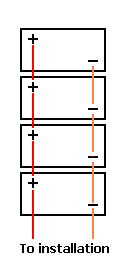(APC 3000) UPS wired up to lots of external (still sealed lead acid) batteries.
I'm sure it has some kind of intelligent gubbins in it which KNOWS it has not been connected to AC power for a while, because despite it showing plenty of volts on my battery pack, (solar charge controller pumping in about 56 volts) the UPS still flashes the one bar of battery LED and beeps . Only when I give it some grid power for a few hours does it shut up.
Anyone else had this problem? Its a brilliant machine apart from that and powers all kinds of stuff here like washing machine, fridge freezer, basically almost everything, as long a it is not all at once!
If i power the whole thing down and hold the 0 button it resets itself and when I turn it back on it shows full battery. (then after an hour of using it it goes back to saying the battery is flat even though its at full voltage)
Charging it with an Outback FM80 and 1500W of PV.
Thanks!
I'm sure it has some kind of intelligent gubbins in it which KNOWS it has not been connected to AC power for a while, because despite it showing plenty of volts on my battery pack, (solar charge controller pumping in about 56 volts) the UPS still flashes the one bar of battery LED and beeps . Only when I give it some grid power for a few hours does it shut up.
Anyone else had this problem? Its a brilliant machine apart from that and powers all kinds of stuff here like washing machine, fridge freezer, basically almost everything, as long a it is not all at once!
If i power the whole thing down and hold the 0 button it resets itself and when I turn it back on it shows full battery. (then after an hour of using it it goes back to saying the battery is flat even though its at full voltage)
Charging it with an Outback FM80 and 1500W of PV.
Thanks!





Comment